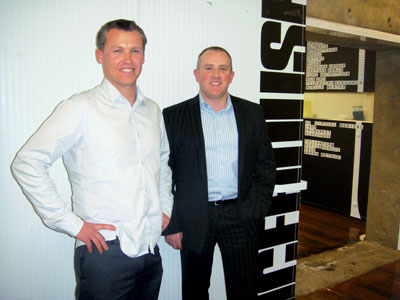Click on the Cloud: New technologies & thinking to boost business productivity
The wrong mindset towards IT investment and new technologies can help businesses lose their competitive edge. This special report examines the impact new technologies can have on productivity, and ultimately the bottom-line. By Glenn Baker.
|
The wrong mindset towards IT investment and new technologies can help businesses lose their competitive edge. This special report examines the impact new technologies can have on productivity, and ultimately the bottom-line. By Glenn Baker. PThis view is backed up by the findings of a research report carried out by ICE Lab, the research arm of The ICEHOUSE Business Growth Centre, late last year and released in March 2009. The report indicates that there is something seriously wrong about the adoption of technology by The key findings of the report perhaps echo what we always suspected was going on out there amongst the nation’s businesses. It is the attitude of the owner-manager that has the greatest effect on IT planning – and simply, if he/she can’t see the link between IT and productivity gains, then sadly IT take up is unlikely to be anything more than a distress purchase (only replace/upgrade it if it breaks). Owner-managers also view business expenditure in the same way as they view personal spending – which means they’re highly cautious, particularly about things they don’t fully understand – like new technology for instance. Their attitude is ‘if it ain’t broke, don’t fix it’ – a far cry from ‘let’s optimise what’s already working’, or even better, ‘let’s see what new technology can do for our growth and productivity’. The report highlighted some other misguided attitudes – namely owner-managers want to take care of their own IT operation themselves. An in-house specialist is too expensive – better to buy in the expertise ad hoc. Also, technology should work for the business owner – supporting their strategy, not setting it. Those surveyed also acknowledge that taking the wrong IT route could ruin productivity, and a common expression that cropped up was that sometimes new technology can be ‘more trouble than it’s worth’. Internal advocates (often people within the company respected by the owner-manager and trusted for their IT know-how) are the most likely third party to influence IT investment it seems. And the report’s figures show many business owners still need convincing that IT really can boost productivity and is worth the investment. Cost is a constant barrier, as is the need to constantly upgrade existing versions of software. Against this backdrop, it’s no wonder IT suppliers are having difficulty convincing businesses to change mindsets – to embrace new technology and new ways of doing things. Creating that disruptive position Waynne Dartnall of managed services provider Business Online Limited (Bizo) has, along with business partner Tim Mulcock, extensive experience in the IT industry and seen incredible changes in the way businesses take-up technology over the years. The speed of change is such that sometimes even IT providers struggle to keep abreast of things he says. “The attitude of many business owners towards IT is that it’s simply a bottomless pit in which to throw money. It’s an essential cost but equipment quickly becomes obsolete and you are constantly told to spend more and more. “Sadly, few take a holistic view of IT and what it can do for business. We find it’s best to work out an overall strategy for clients. Discuss what’s important to the business and put an IT strategy in place accordingly. “When it comes to implementing new technology, change can be incremental. Do it over two years as budgets allow and at a speed your culture can adjust to.” Dartnall says many business owners miss out on the true potential of their employees because they fail to provide the tools and technology that enable greater productivity. “Often staff have more computing power at home than at work, which they use to engage and collaborate with friends and family around the world. Then they come to work where it’s all very structured and limited, and to talk to a customer they have to pick up the phone. “Businesses should embrace tools that enhance the work environment for staff and create high-tech ways of interacting with customers – for example web conferencing and online document sharing. Not only does it save time, more importantly, it creates a point of difference from your competitors. “Use technology to be disruptive in the marketplace,” says Dartnall. “It’s one of the best ways to do that.” Technology is a linchpin for reducing costs and increasing revenue, he adds. It allows staff to integrate work and family time; it makes downtime productive and provides the flexibility to work from anywhere – all tangible benefits especially for those having to adjust to working in a recession. “Technology doesn’t have to be expensive either. Perhaps, in the past the IT industry is to blame for making it so by pushing the latest gadgets onto customers,” says Dartnall. “But those days are over. Nowadays it’s about maximising productivity out of what you can afford – in the case of videoconferencing, for example, use a simple desktop PC solution rather than a full-on system with all the bells and whistles.” Productivity in a cloud Arguably the single biggest factor in IT that will influence the productivity of individuals and businesses as a whole over the next five to ten years is the advent of what’s known as ‘cloud computing’. Make no mistake, this is perhaps the most significant development since the arrival of the Internet, because the productivity gains and cost benefits are huge. What is ‘cloud computing’? In simple terms, it is software, services and computing power delivered over the web. “You may have heard businesses refer to the cloud as software-as-a-service or SaaS, but for employees, it’s all about using applications via the web to do their job more effectively,” explains Richard Suhr, head of enterprise for Google in eople understandably have a love-hate relationship with technology. Love it when it works, hate it when it doesn’t. In a land once hailed as a nation of early adopters, I believe many business owners have developed poor attitudes towards business technology (which we’ll refer to, for the purposes of this article, as ‘IT’ or Information Technology). |
It’s not the applications delivered via the cloud that are necessarily revolutionary, says Suhr. Rather, it is how businesses are using cloud applications to connect their employees across the globe that is fundamentally changing the way companies work. After all, the work day changes when colleagues can create, update and simultaneously share information online, at any time. The recent swine flu scare also highlighted how cloud computing can maintain worker productivity when employees are confined to their home. “You can set up employees to work from home within days, all you need is an Internet browser,” says Suhr. “At US$50 per user per annum, with no license surprises, Google Apps are highly cost effective.” On the subject of employee productivity, Suhr’s work with forward-thinking firms has produced the following observations: • The war room has become global. When you need to work with an international office on a presentation, the ‘cloud’ means less time is spent collating feedback and consolidating it into one document. This process is done seamlessly via the web. Instant messaging means colleagues can communicate with each other immediately, so ideas and feedback are exchanged instantaneously. • Anytime, anywhere. People can log-in to their systems anywhere to work on a document or to connect with fellow work-mates, be it in an Internet cafe or via a BlackBerry or smartphone. The cloud lets employees work on a project the same way they share photos, chat online via a social network or invite comment on their blog. • An explosion of creative thinking. Ideas are being quickly shared across borders, letting colleagues move beyond the confinement of a specific workspace to collaborate and brainstorm on a global scale. • Changing work/life balance. For employers and business owners, having a business operate in the cloud means less time pressure, minimal software license fees, and fewer costly upgrades – that’s because cloud applications are effectively ‘version-less’. Your staff enjoy the use of the latest technology without having to wait for the packaged version to arrive. It’s even possible to run your entire business in the cloud, with nothing more than a desktop or portable PC, and no other expensive hardware. One person who not only runs a business entirely in the cloud, but is also starting up a company that will help businesses to utilise cloud computing solutions, is Nicholas Bartlett of Saasilia.com. Sassilia can provide cloud software solutions that cover every aspect of business, including email, calendar, contact management, tasks, word processing, spreadsheets, presentations, online collaboration of documents, spreadsheets and presentations, online and video chat, telephony, CRM, accounting, and secure backup. All for a low annual fee. But don’t rush them just yet – although they debuted at the recent RightClick seminar in (And in case you can’t bear the thought of making the switch from Outlook – those clever Google people have made it compatible with Apps, so you don’t need to change.) It’s fair to say that, unless you’re starting a business from scratch, it would be difficult switching entirely to a cloud model for your IT needs. First you need to understand how it works. Warwick Grey, marketing manager Personal Systems Group for Hewlett Packard New Zealand, points out that if you already use Hotmail or Gmail, then you’re basically already using cloud computing – albeit through your browser. As for peoples’ security fears when accessing services online, particularly backup services, Grey says these are groundless and based primarily on our fear of historical threats such as viruses and cookies.
|





